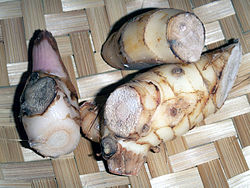Note: This is a project under development. The articles on this wiki are just being initiated and broadly incomplete. You can Help creating new pages.
Alpinia galanga - Kulañjana
Galangal is a robust plant. Growing in large clumps that can be 2 - 3.5 metres tall. A fairly well-known and widely used spice, mainly employed as a flavouring in foods and as a medicinal plant.
Contents
[hide]- 1 Uses
- 2 Parts Used
- 3 Chemical Composition
- 4 Common names
- 5 Properties
- 6 Habit
- 7 Identification
- 8 List of Ayurvedic medicine in which the herb is used
- 9 Where to get the saplings
- 10 Mode of Propagation
- 11 How to plant/cultivate
- 12 Commonly seen growing in areas
- 13 Photo Gallery
- 14 References
- 15 External Links
Uses
Indigestion, Colic, Dysentery, Skin diseases, Enlarged spleen, Respiratory diseases, Cancers of mouth, Cancers of stomach, Systemic infections, Cholera
Parts Used
Rhizomes, Flowers, Fruits, Fresh rootstack, Dried rootstack.
Chemical Composition
Essential oil, containing α - pinene, β - pinene, limonene, cineol, terpinen - 4 - ol and α - terpineol.[1]
Common names
| Language | Common name |
|---|---|
| Kannada | Doddarasagadde, Dhoomraasmi |
| Hindi | Kulanjan, Kulinjan |
| Malayalam | Aratta, Ciffaratta |
| Tamil | Arattai, Sittarattai |
| Telugu | Dumparaastramu |
| Marathi | NA |
| Gujarathi | NA |
| Punjabi | NA |
| Kashmiri | NA |
| Sanskrit | Sugandhamūla, Malaya Vacā, Sthūlagranthiḥ, Mahābharū Vacā, Rāsnā |
| English | Greater galangal, Javagalangal |
Properties
Reference: Dravya - Substance, Rasa - Taste, Guna - Qualities, Veerya - Potency, Vipaka - Post-digesion effect, Karma - Pharmacological activity, Prabhava - Therepeutics.
Dravya
Rasa
Tikta, Kaṭu
Guna
Guru
Veerya
Uṣṇa
Vipaka
Kaṭu
Karma
Vātahara, Kaphahara, Pācana, Rucya, Svarya, Mukha ṣodhaka, Viḍaghna
Prabhava
Habit
Identification
Leaf
| Kind | Shape | Feature |
|---|---|---|
| Simple | Oblong | Leaf arrangement is alternate |
Flower
| Type | Size | Color and composition | Stamen | More information |
|---|---|---|---|---|
| Unisexual | 2-4cm long | pink | Flowering throughout the year and In terminal and/or axillary pseudoracemes |
Fruit
| Type | Size | Mass | Appearance | Seeds | More information |
|---|---|---|---|---|---|
| oblong pod | Thinly septate, pilose, wrinkled | seeds upto 5 | Fruiting throughout the year |
Other features
List of Ayurvedic medicine in which the herb is used
Where to get the saplings
Mode of Propagation
How to plant/cultivate
Rhizome splits are used as planting material for commercial cultivation. Seed propagation is not feasible due to low germination rate. [3]
Commonly seen growing in areas
Photo Gallery
References
- Jump up ↑ The Ayuredic Pharmacopoeia of India Part-1, Volume-5, Page no-14
- Jump up ↑ [Morphology]
- Jump up ↑ Cultivation detail
External Links
- Ayurvedic Herbs known to be helpful to treat Indigestion
- Ayurvedic Herbs known to be helpful to treat Colic
- Ayurvedic Herbs known to be helpful to treat Dysentery
- Ayurvedic Herbs known to be helpful to treat Skin diseases
- Ayurvedic Herbs known to be helpful to treat Enlarged spleen
- Ayurvedic Herbs known to be helpful to treat Respiratory diseases
- Ayurvedic Herbs known to be helpful to treat Cancers of mouth
- Ayurvedic Herbs known to be helpful to treat Cancers of stomach
- Ayurvedic Herbs known to be helpful to treat Systemic infections
- Ayurvedic Herbs known to be helpful to treat Cholera
- Herbs with Rhizomes used in medicine
- Herbs with Flowers used in medicine
- Herbs with Fruits used in medicine
- Herbs with Fresh rootstack used in medicine
- Herbs with Dried rootstack used in medicine
- Herbs with common name in Kannada
- Herbs with common name in Hindi
- Herbs with common name in Malayalam
- Herbs with common name in Tamil
- Herbs with common name in Telugu
- Herbs with common name in Sanskrit
- Herbs with common name in English
- Habit - Perennial plant
- Index of Plants which can be propagated by Seeds
- Index of Plants which can be propagated by Division of rhizome
- Herbs that are commonly seen in the region of Forest margins
- Herbs that are commonly seen in the region of Grasslands
- Herbs
- Zingiberaceae




